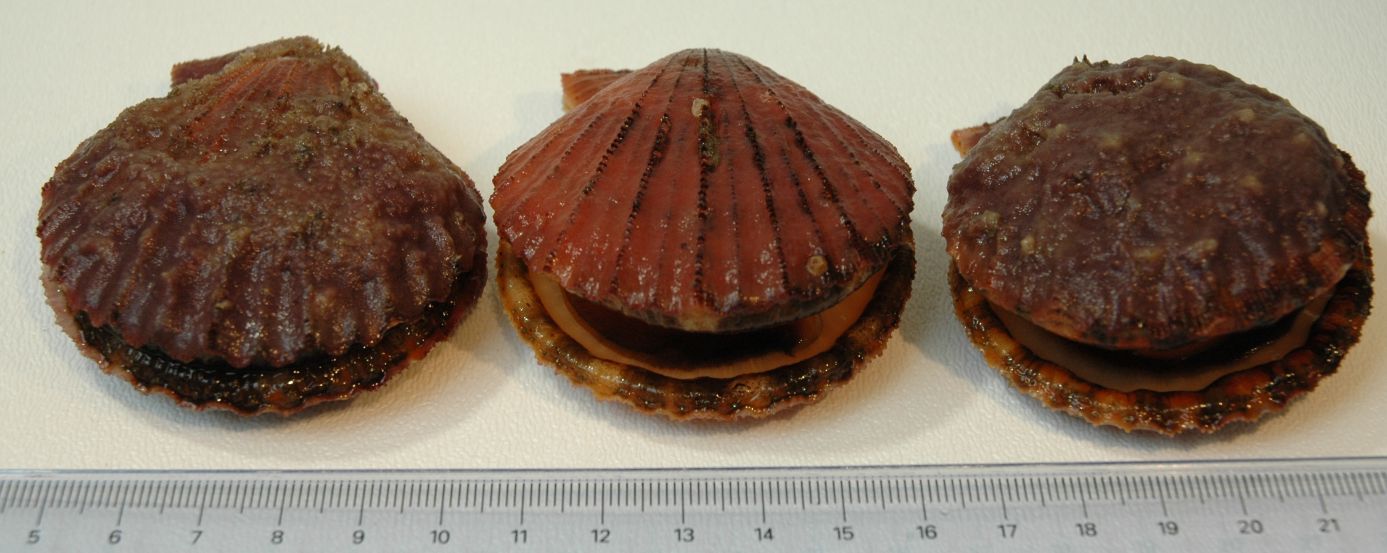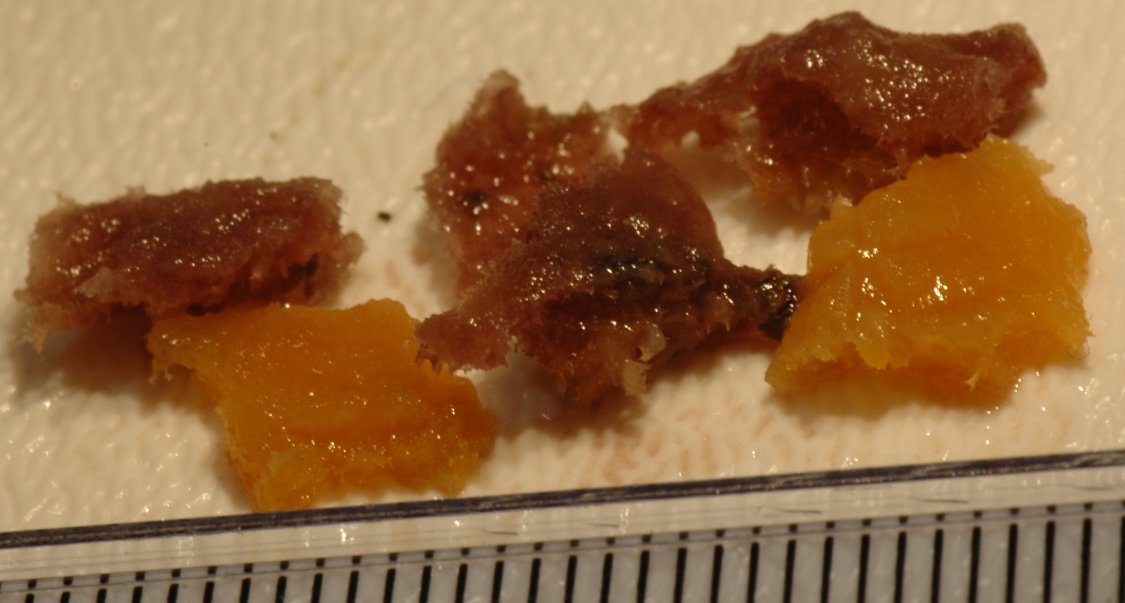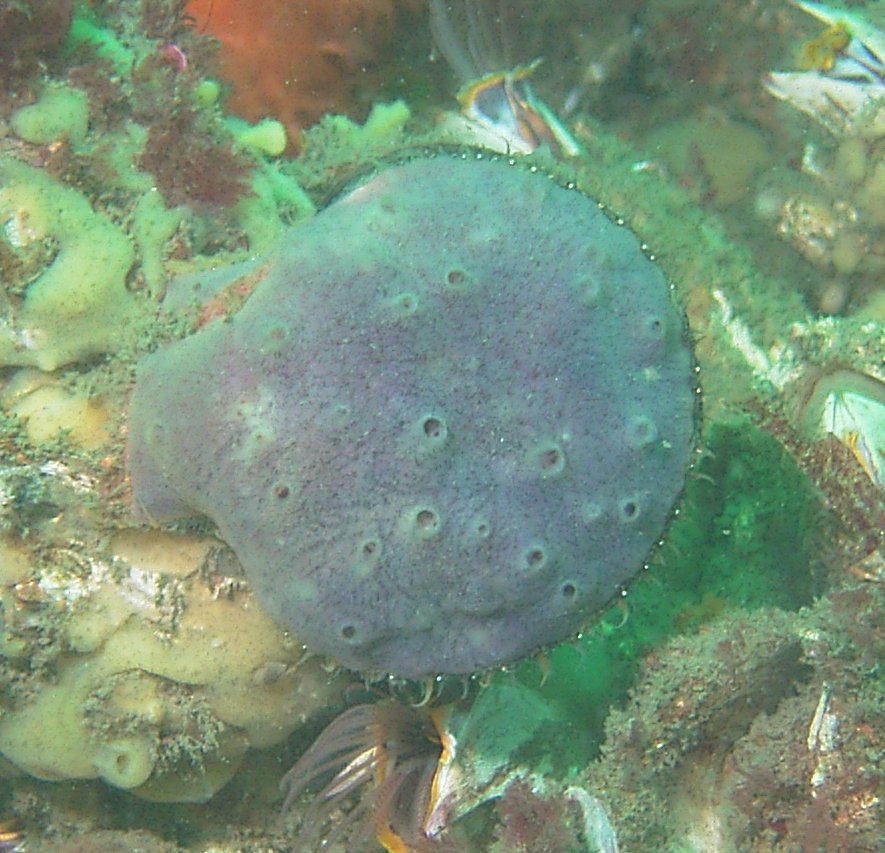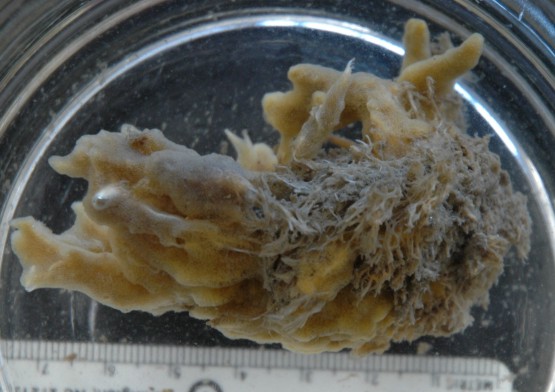Mycale adhaerens (Lambe, 1894)Common name(s): Purple scallop sponge |
|
| Synonyms: Esperella adhaerens |  |
| Phylum
Porifera
Class Demospongiae Subclass Ceractinomorpha Order Poecilosclerida Family Mycalidae |
|
| Mycale adhaerens sponges of different hues on Chlamys hastata scallops. The scallop on the right also has a Myxilla incrustans sponge growing on the lower valve (not visible). Collected at 15 m depth, Coffin Rocks. | |
| (Photo by: Dave Cowles, July 2005) | |
How to Distinguish from Similar Species: The only other sponge regularly found growing on scallops in this region is Myxilla incrustans, which is bright yellow to brown. M. W. de Laubenfels (quoted in Ricketts et al.) says that Mycale adhaerens may also be distinguished by comparatively coarser structure and by the fact that, when torn, it reveals prominent fibers thicker than thread, absent in Myxilla. (see photo). Lambe also said that the oscula in Mycale adhaerens were much smaller than those in Myxilla encrustans.
Geographical Range:
Depth Range:
Habitat: Live symbiotically on scallop shells.
Biology/Natural History: Nudibranches which graze on this sponge include Archidoris odhneri and Anisodoris nobilis. The symbiosis is likely mutualistic. If one of the major predators of the scallop, the seastar Evasterias troschelii, encounters the scallop (and the scallop does not swim away) the seastar often turns away if it touches the sponge; likely in response to some secretion or to the spicules from the sponge. The sponge also appears to make it more difficult for the seastar's tube feet to adhere to the scallop. If the sponge is removed from the scallop and the scallop is prevented from swimming, it is readily captured by the seastar. The scallop will also swim from predators of the sponge, such as Archidoris spp, so the sponge is benefited as well. The swimming scallop may also help carry the sponge into areas with clean water and good currents, and help prevent fouling of the sponge.
Research by Kirt Onthank and Thomas Ewing at the Walla Walla
University
Rosario Marine Laboratory indicates that sponge encrustation deters
scallop
predation by octopus Enteroctopus
dofleini and Octopus
rubescens, both of which may be important scallop
predators in
our area.
A tropical near-relative of this sponge, Mycale grandis, harbors microbes from which it appears to obtain amino acids directly rather than obtaining them from particles filtered from the water column. The sponge pumps water through itself, but that pumping may be largely to supply food to the microbes.Shih, J.L., C.B. Wall, N.J. Wallsgrove, M.P. Lesser, and B.N. Popp, 2019. Trophic ecology of the tropical pacific sponge Mycale grandis inferred from amino acid compound-specific isotopic analysis. Microbial Ecology Jul 17, 2019 epub. doi:10.10.1007/s00248-019-01410-x
| Return to: | |||
| Main Page | Alphabetic Index | Systematic Index | Glossary |
References:
Dichotomous Keys:Kozloff 1987, 1996
General References:
Johnson
and Snook, 1955
Morris
et al., 1980
O'Clair
and O'Clair, 1998
Ricketts
et al., 1985
Scientific Articles:
Carballo,
Jose L. and Jose A. Cruz-Barraza, 2010. A revision
of the genus Mycale
(Poecilosclerida: Mycalidae) from the Mexican Pacific Ocean.
Contributions to Zoology 79:4
Farren, H.M. and D. A. Donovan, 2007. Effects of sponge and
barnacle
encrustation on survival of the scallop Chlamys hastata.
Hydrobiology
592: 225-234
General Notes and Observations: Locations, abundances, unusual behaviors:
Neither Myxilla incrustans nor Mycale adhaerens last long in running seawater tanks. Within a few days they begin to slough off the scallops. Perhaps they need strong and nearly constant water flow. We find scallops with sponges primarily in areas subject to strong currents.
Mycale adhaerens is less common on scallops in the Rosario area than is Myxilla incrustans. Some areas seem to have only Myxilla encrustans, while others have mostly Myxilla encrustans and some Mycale adhaerens. This identification is made just by sight--the yellow symbiotic ones are assumed to by Myxilla incrustans.
In 2006 we sampled a number of freeliving sponges and found Mycale adhaerens in a number of different places, including yellow branching specimens from the mud of Padilla Bay and yellow encrusting specimens from Northwest Island.

These are torn sponge fragments. Myxilla
incrustans is yellow and Mycale adhaerens
is purple.
Note the more stringy appearance of the Mycale.
Scale is millimeters.
Photo by Dave Cowles, July 2005.

In this underwater photo Mycale adhaerens is
attached to its
host scallop, which in turn is attached to a rock. Photo by
Jim Nestler
July 2005
Mycale adhaerens is not limited to growing
on scallops.
The sponge shown below is often found growing in Padilla Bay near March
Point June 2006. It is tan with yellowish parts when fresh
and quickly
fades to all tan after being collected. According to the
spicules
and growth form this is also Mycale adhaerens.

| Types of glass spicules found in Mycale adhaerens (spicules below photographed and measured from the yellow specimen above from Padilla Bay). The small, hairlike objects also seen in the photos were some unknown, non-glass material found in some but not all specimens of this species that we studied. Spicules isolated by Brooke Reiswig. Photos taken with a phase-contrast microscope. | ||
 |
 |
 |
| Styles
(a megasclere)
We measured styles from 280-318 microns long from the above freeliving specimen and 290-390 microns long from a sponge attached to a scallop.. |
A sigma
(a microsclere,
top left, C-shaped.) [An anisochela is at bottom right]
We measured sigmas from 26-59 microns long from the above freeliving specimen and one 46 microns long from a sponge attached to a scallop (sigmas were very rare in the scallop sponge). |
An anisochela
(a
microsclere)
We measured anisochelas from 46-49 microns long from the above freeliving specimen and 26-74 microns long from a sponge attached to a scallop. |
Authors and Editors of Page:
Dave Cowles (2005): Created original page